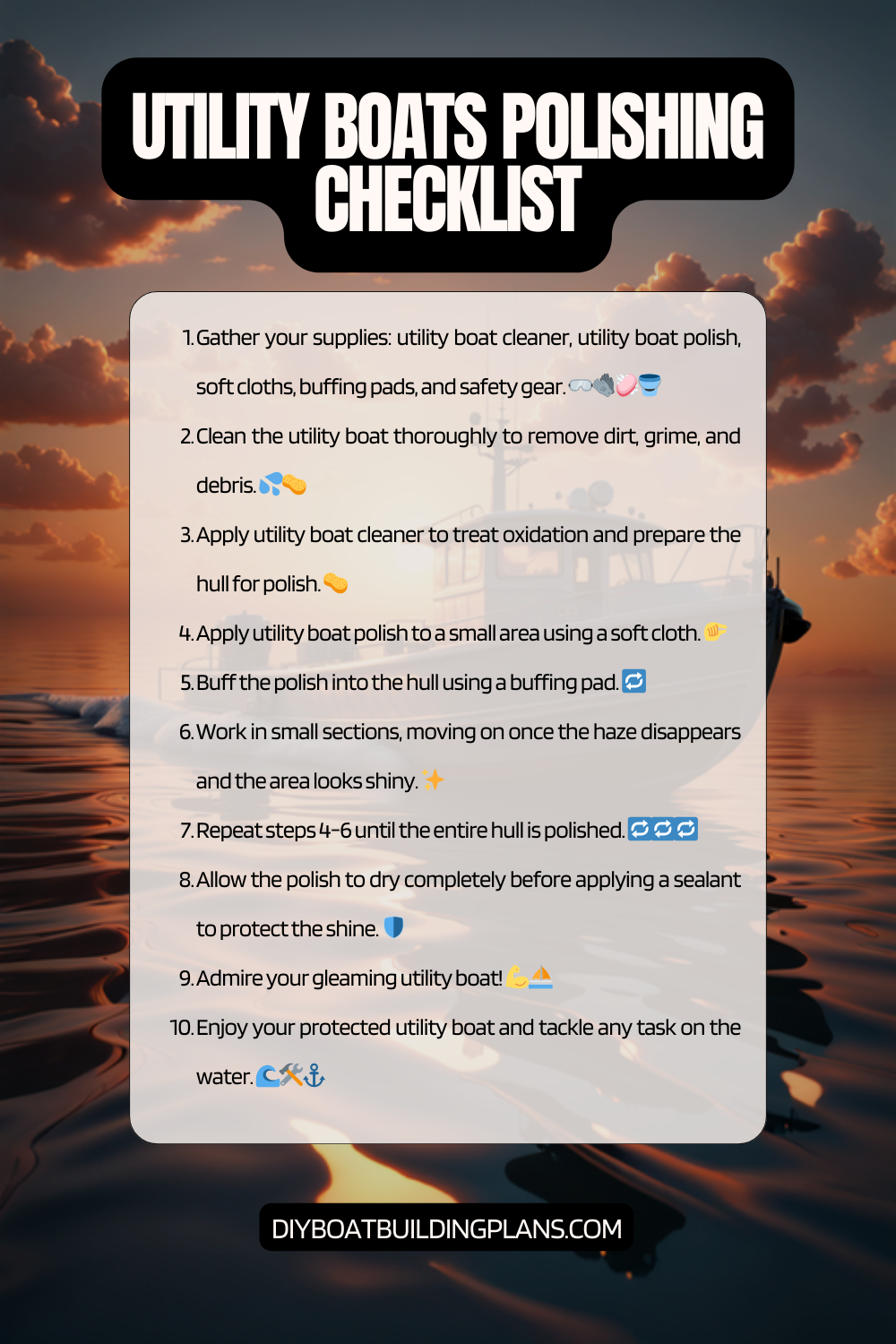Overview of Utility Boats Polishing Tips
Utility boats are versatile vessels that serve various purposes, such as transportation, maintenance, and rescue operations. These boats are designed to withstand harsh conditions and perform demanding tasks. However, like any other watercraft, utility boats require regular maintenance to ensure their longevity and optimal performance. One crucial aspect of boat maintenance is polishing, which involves enhancing the appearance of the boat’s surfaces. Polishing utility boats not only improves their aesthetic appeal but also protects them from the damaging effects of environmental factors.
Key Takeaways
- Polishing utility boats is important for maintaining their appearance and protecting them from damage.
- Choosing the right polishing products and preparing the boat properly are key to achieving a polished surface.
- Polishing techniques vary depending on the area of the boat being polished, such as the hull, deck, metal parts, and windows.
- Regular maintenance is necessary to keep the polished surface looking its best.
- With the right tools and techniques, polishing a utility boat can be a simple and rewarding task.

Importance of Polishing Utility Boats
Polishing utility boats offers numerous benefits that go beyond mere aesthetics. Firstly, it helps to protect the boat’s surfaces from environmental factors such as UV rays, saltwater, and pollutants. These elements can cause fading, oxidation, and corrosion, leading to structural damage over time. By applying a protective layer through polishing, you create a barrier that shields the boat’s surfaces from these harmful elements.
Secondly, polishing utility boats can extend their lifespan. Regular polishing helps to maintain the integrity of the boat’s gel coat or paint job, preventing it from deteriorating prematurely. This not only preserves the boat’s value but also saves you money in the long run by reducing the need for costly repairs or repainting.
Choosing the Right Polishing Products
When it comes to polishing utility boats, choosing the right products is essential for achieving optimal results. There are various types of polishing products available on the market, including compounds, polishes, waxes, and sealants. Compounds are used for removing heavy oxidation and scratches, while polishes are designed to restore shine and remove light imperfections. Waxes and sealants provide a protective layer that enhances durability.
When selecting polishing products for your utility boat, consider factors such as the type of surface you are working on (gel coat or painted), the level of oxidation or damage present, and the desired outcome. It is crucial to choose products specifically formulated for marine use, as they are designed to withstand the unique challenges of boating, such as exposure to saltwater and UV rays.
Preparing the Boat for Polishing
| Task | Time Required | Materials Needed | Tools Required |
|---|---|---|---|
| Cleaning the Boat | 2 hours | Boat soap, water, scrub brush, sponge | Bucket, hose |
| Sanding the Boat | 4 hours | Sandpaper (various grits), sanding block, masking tape | Orbital sander, dust mask, safety glasses |
| Applying Compound | 3 hours | Compound, applicator pad, microfiber towel | Buffer, extension cord |
| Polishing the Boat | 2 hours | Polish, applicator pad, microfiber towel | Buffer, extension cord |
Before diving into the polishing process, it is essential to prepare the boat properly. Start by thoroughly cleaning the boat’s surfaces to remove any dirt, grime, or salt residue. Use a mild detergent and a soft brush or sponge to avoid scratching the surface. Rinse the boat thoroughly with fresh water and allow it to dry completely.
Next, if there is any old wax or polish present on the boat’s surfaces, it needs to be removed before applying new products. This can be done using a wax remover or a compound specifically designed for this purpose. Follow the manufacturer’s instructions and use a clean cloth or applicator pad to remove the old wax or polish.
Polishing Techniques for Utility Boats
There are several techniques you can use to polish utility boats, depending on your preference and the condition of the surfaces. Hand polishing involves applying the polishing product directly onto a clean cloth or applicator pad and rubbing it onto the surface in circular motions. This method is suitable for small areas or when working on delicate surfaces.
Machine polishing involves using a rotary or dual-action polisher equipped with a foam or wool pad. This technique allows for faster and more efficient polishing, especially when dealing with larger areas or heavily oxidized surfaces. It is important to use the appropriate speed and pressure to avoid damaging the boat’s surfaces.
Buffing is another technique commonly used in boat polishing. It involves using a buffing wheel attached to a rotary polisher to remove imperfections and restore shine. Buffing is particularly effective for removing heavy oxidation and scratches but should be done with caution to prevent overheating or burning the gel coat or paint.
Polishing the Hull of a Utility Boat
Polishing the hull of a utility boat requires careful attention to detail to achieve a smooth and glossy finish. Start by applying a small amount of polishing product onto a clean cloth or applicator pad. Work in small sections, applying the product in circular motions. Continue rubbing until the product starts to dry, then buff it off using a clean microfiber cloth.
To achieve an even finish, it is essential to overlap each section slightly and maintain a consistent pressure. Pay extra attention to areas that are prone to oxidation or damage, such as the waterline or areas exposed to the sun. Repeat the process until the entire hull is polished to your desired level of shine.
Polishing the Deck of a Utility Boat
The deck of a utility boat is often subjected to heavy foot traffic and exposure to various elements. Polishing the deck not only enhances its appearance but also helps to protect it from wear and tear. Start by applying a small amount of polishing product onto a clean cloth or applicator pad. Work in small sections, applying the product in circular motions.
When polishing the deck, it is important to avoid non-skid surfaces, as they can become slippery if polished. Use masking tape or a plastic sheet to protect these areas from accidental contact with the polishing product. Once you have finished polishing the deck, remove the tape or plastic sheet and buff off any residue using a clean microfiber cloth.
Polishing the Metal Parts of a Utility Boat
Metal parts on utility boats, such as railings, cleats, and fittings, can become dull or tarnished over time. Polishing these metal surfaces not only restores their shine but also helps to prevent corrosion. Start by cleaning the metal parts using a mild detergent and a soft brush or sponge. Rinse thoroughly with fresh water and dry completely.
Next, apply a small amount of metal polish onto a clean cloth or applicator pad. Work in small sections, applying the polish in circular motions. Continue rubbing until the polish starts to dry, then buff it off using a clean microfiber cloth. Be careful not to apply too much pressure, as this can cause scratches or damage to the metal surfaces.
Download over 500 Boat Plans. Click on the link below.
-->Click Here<--
Polishing the Windows of a Utility Boat
The windows of a utility boat are not only functional but also contribute to its overall appearance. Polishing the windows helps to remove dirt, grime, and water spots, resulting in clear and streak-free visibility. Start by cleaning the windows using a glass cleaner or a mixture of vinegar and water. Use a soft cloth or paper towel to avoid scratching the glass.
Next, apply a small amount of glass polish onto a clean cloth or applicator pad. Work in small sections, applying the polish in circular motions. Continue rubbing until the polish starts to dry, then buff it off using a clean microfiber cloth. Be sure to remove any residue or streaks for optimal clarity.
Maintaining the Polished Surface of a Utility Boat
Once you have polished your utility boat, it is important to maintain the polished surface to ensure its longevity. Regularly wash the boat with fresh water and a mild detergent to remove dirt, salt residue, and other contaminants. Avoid using abrasive cleaners or brushes that can scratch the surface.
Additionally, consider applying a protective wax or sealant every few months to maintain the shine and protect against environmental factors. These products create a barrier that helps to repel water, UV rays, and pollutants. Be sure to follow the manufacturer’s instructions for application and reapplication.
Utility Boats Polishing Checklist

Conclusion – Utility Boats Polishing Tips
In conclusion, polishing utility boats is an essential part of their maintenance routine. It not only enhances their appearance but also protects them from environmental factors that can cause damage over time. By choosing the right polishing products and following proper techniques, you can achieve a smooth and glossy finish on the hull, deck, metal parts, and windows of your utility boat.
Remember to prepare the boat properly by cleaning and removing old wax or polish before starting the polishing process. Take care to avoid non-skid surfaces when polishing the deck and use caution when working on metal parts to prevent scratches or damage. Finally, maintain the polished surface by regularly washing the boat and applying a protective wax or sealant.
By following these tips and incorporating regular polishing into your boat maintenance routine, you can ensure that your utility boat remains in top condition for years to come.
FAQs – Utility Boats Polishing Tips
What are utility boats?
Utility boats are small to medium-sized boats that are designed for various tasks such as transportation, fishing, and recreation. They are typically made of aluminum or fiberglass and are powered by outboard motors.
Why is polishing important for utility boats?
Polishing is important for utility boats because it helps to protect the boat’s surface from the damaging effects of the sun, saltwater, and other environmental factors. It also helps to maintain the boat’s appearance and can increase its resale value.
What materials are needed for polishing a utility boat?
Materials needed for polishing a utility boat include a polishing compound, a buffing pad, a polishing cloth, and a power buffer. It is also important to have a clean and dry surface to work on.
How often should a utility boat be polished?
The frequency of polishing a utility boat depends on how often it is used and the conditions it is exposed to. As a general rule, it is recommended to polish a boat at least once a year, but more frequent polishing may be necessary for boats that are used frequently or in harsh environments.
What are some tips for polishing a utility boat?
Some tips for polishing a utility boat include starting with a clean and dry surface, using a polishing compound that is appropriate for the boat’s surface, working in small sections, and using a power buffer to achieve a smooth and even finish. It is also important to wear protective gear such as gloves and eye protection.



